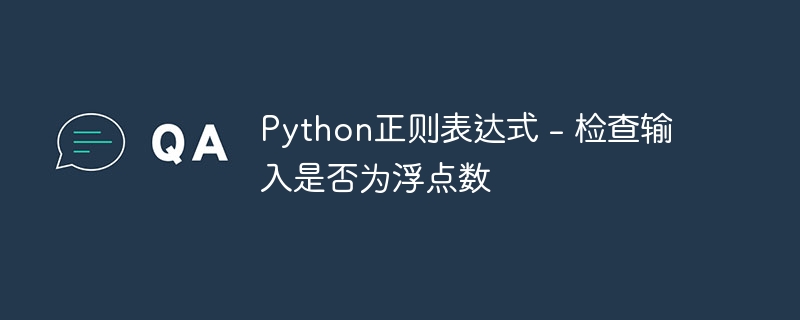

Floating point numbers play a vital role in a variety of programming tasks, from mathematical calculations to data analysis. However, when dealing with user input or data from external sources, it becomes critical to verify that the input is a valid floating point number. Python provides powerful tools to address this challenge, one of which is regular expressions.
In this article, we will explore how to use regular expressions in Python to check if the input is a floating point number. Regular expressions (often called regex) provide a concise and flexible way to define patterns and search for matches in text. By leveraging regular expressions, we can construct a pattern that exactly matches the floating point format and validate the input accordingly.
In this article, we will explore how to use regular expressions in Python to check if the input is a floating point number. Regular expressions (often called regex) provide a concise and flexible way to define patterns and search for matches in text. By leveraging regular expressions, we can construct a pattern that exactly matches the floating point format and validate the input accordingly.
Floating point numbers are the data type used to represent real numbers in computer systems. They are called "floating point" because the decimal point can "float" to represent numbers of different sizes. In Python, floating point numbers are represented using the float data type.
Floating point numbers can have both an integer part and a decimal part, and can be positive or negative. They are usually written in the form m.n, where m represents the integer part and n represents the fractional part. For example, 3.14 and -0.5 are valid floating point numbers.
However, it should be noted that due to computer hardware limitations, not all decimal representations can be accurately represented as floating point numbers. This can sometimes lead to unexpected results for calculations involving floating point numbers. Therefore, it becomes critical to validate the input and ensure that it conforms to the expected format.
In the next section, we will explore regular expressions and learn how to use them to check whether the input is a valid floating point number.
Regular expressions (often abbreviated to regex) are powerful tools for pattern matching and text manipulation. They provide a concise and flexible way to define patterns and search for specific character sequences in strings.
In Python, the re module provides functions and methods for using regular expressions. We can leverage the power of regular expressions to check if the input is a valid floating point number.
To validate floating point numbers using regular expressions, we need to define a pattern that matches the expected format. The following are the key components of the pattern−
Optional symbols−Numbers can start with an optional positive sign ( ) or negative sign (-).
Integer part−Numbers can have an optional integer part, which can consist of one or more digits.
Optional decimal point−Numbers can contain an optional decimal point (.) to separate the integer part and the decimal part.
Decimal part−Numbers can have an optional decimal part consisting of one or more digits.
Exponent−Numbers may have an optional exponent part, represented by the letter "e" or "E", followed by an optional symbol and one or more numbers.
By constructing a regular expression pattern containing these components, we can effectively check whether the input string matches the floating point pattern.
In the next section, we will delve into the implementation of a Python program that uses regular expressions to check floating point numbers.
To check if a given input is a floating point number using regular expressions in Python, we can follow these steps−
Import re module−First import the re module, which provides functions and methods for using regular expressions.
Define a regular expression pattern−Create a regular expression pattern that matches the expected format of a floating point number. This mode will be used to validate input.
Create function−Define a function, let’s call it is_float, which takes the input string as a parameter.
Match pattern−Use the re.match() function to match the input string with the regular expression pattern. This function returns a match object if the pattern matches the string, or None if it does not match.
Check if it matches−Use the if statement to check if the matching object is not None. If not None, the input string is a valid floating point number.
Return result−In the if statement, returning True means that the input is a floating point number. Otherwise, returns False.
Now, let’s put it all together and write Python code to check floating point numbers using regular expressions−
import re def is_float(input_string): pattern = r'^[-+]?[0-9]*\.?[0-9]+([eE][-+]?[0-9]+)?$' match = re.match(pattern, input_string) if match: return True return False
In the above code, we define the regular expression pattern r'^[- ]?[0-9]*\.?[0-9] ([eE][- ]?[0-9 ] )?$', which matches the expected format of a floating point number. We use re.match() to match the input string against the pattern and return True if it matches.
In the next section, we will test the is_float() function with some example inputs to see how it works.
Here are some test cases we can try -
Test Case 1−
Enter−“3.14”
Expected output−Correct
Explanation−The input is a valid floating point number.
Test Case 2−
Enter−“-0.5”
预期输出−正确
说明−输入是有效的浮点数。
测试用例 3−
输入−“10”
预期输出−错误
说明−输入不是浮点数,因为它没有小数部分。
测试用例 4−
输入−“abc”
预期输出−错误
说明−输入不是浮点数,因为它包含非数字字符。
测试用例 5−
输入−“1.23e-4”
预期输出−正确
说明−输入是以科学计数法表示的有效浮点数。
您可以通过使用这些输入调用 is_float() 函数并将输出与预期结果进行比较来测试程序。如果输出与所有测试用例的预期结果相匹配,则表明程序运行正常。
# Testing the program print(is_float("3.14")) # Expected output: True print(is_float("-0.5")) # Expected output: True print(is_float("10")) # Expected output: False print(is_float("abc")) # Expected output: False print(is_float("1.23e-4")) # Expected output: True
在本文中,我们探讨了如何在 Python 中使用正则表达式来检查给定输入是否为浮点数。我们了解了正则表达式在模式匹配中的重要性以及如何应用它们来验证数字输入。
我们首先了解浮点数的特征以及它们的常见表示格式。然后,我们深入研究 is_float() 函数的实现,使用正则表达式检查浮点数。我们还讨论了使用 re.match() 函数进行精确字符串匹配的重要性。
通过使用多个测试用例对程序进行测试,我们确保了其可靠性,并验证了它能够正确识别浮点数,同时拒绝无效输入。
The above is the detailed content of Python regular expression - check if input is float. For more information, please follow other related articles on the PHP Chinese website!




